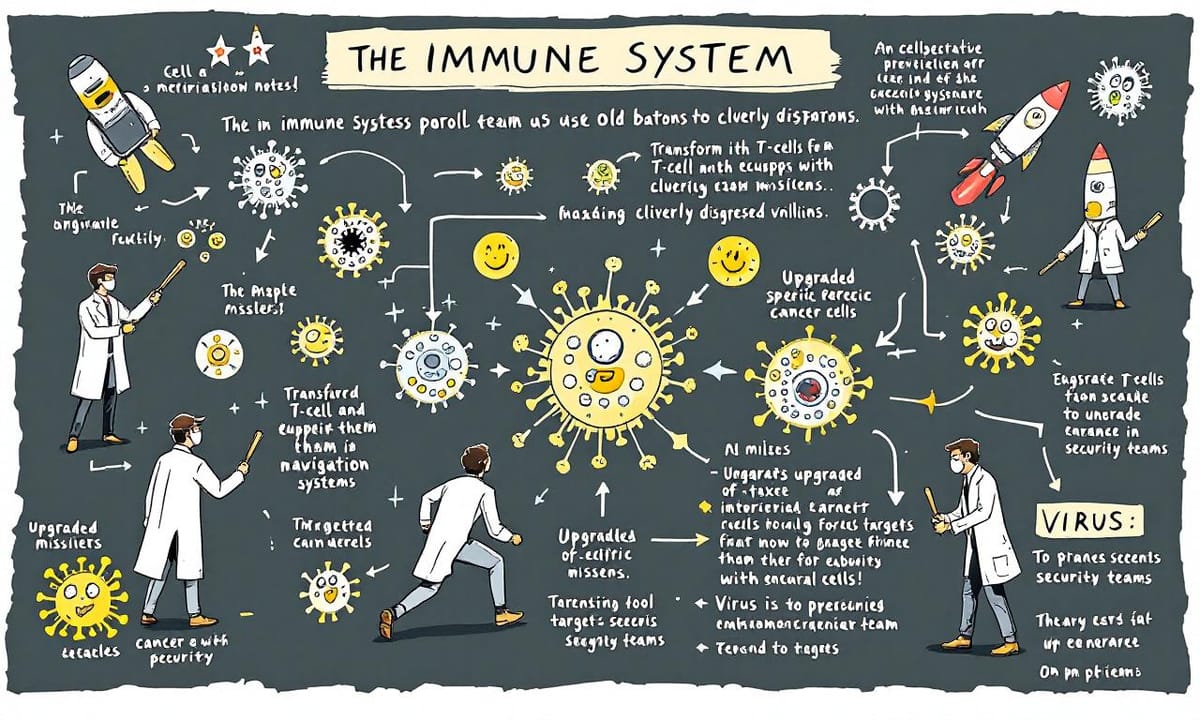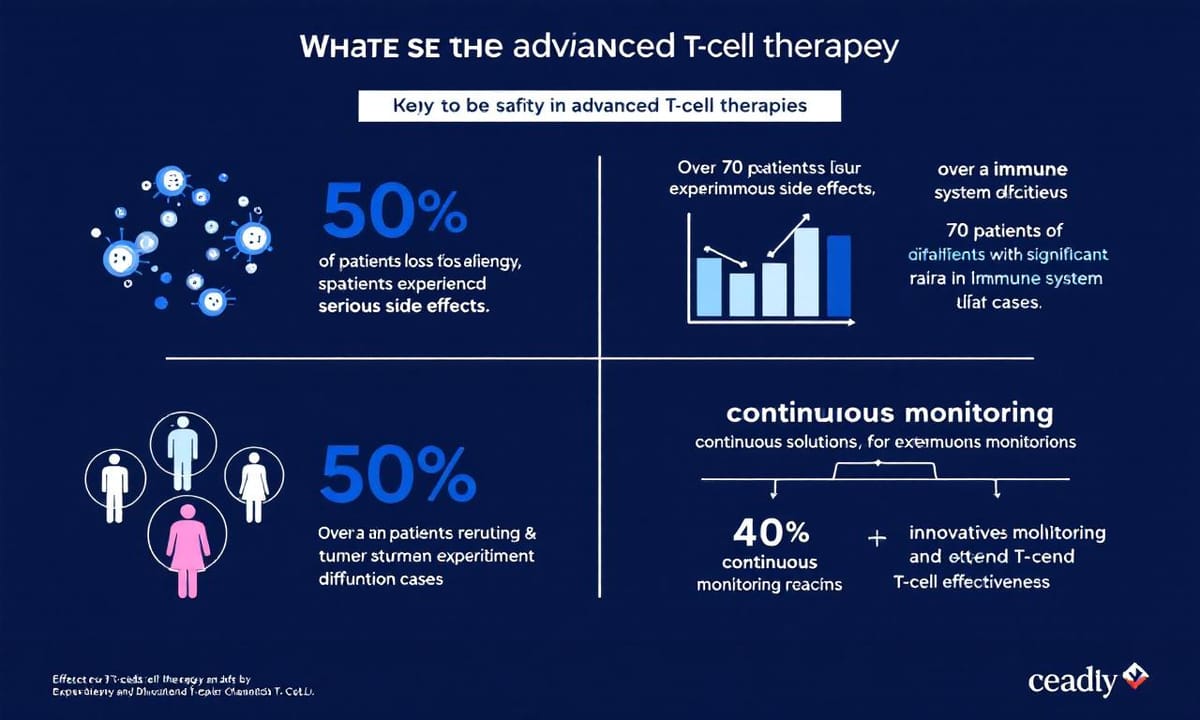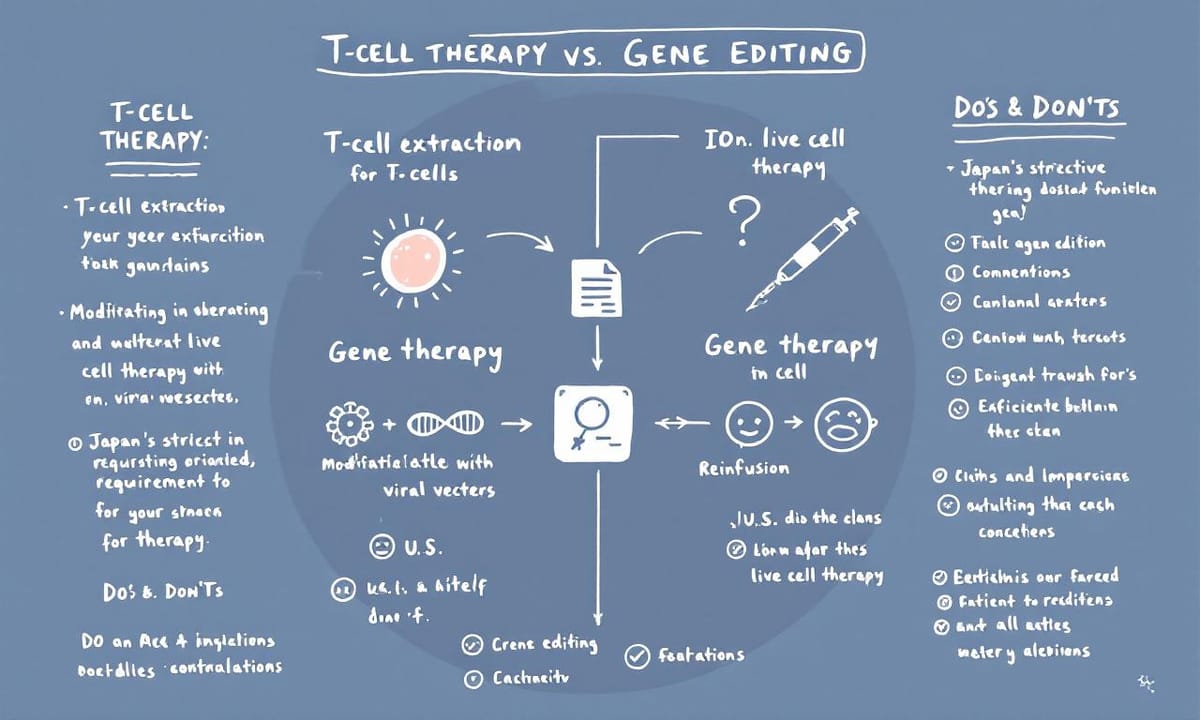馬上可以做的事 - 協助病患與家屬把握CAR-T療法關鍵環節,爭取更高治療效益與安全保障
- 諮詢血液腫瘤專科醫師及官方衛教平台,評估自身是否適合CAR-T療法。
能提前掌握適應症條件和副作用資訊,減少延誤黃金治療時機。
- 記錄每次治療後7天內的不適症狀並回報醫護人員。
可及早偵測並處理常見副作用,降低嚴重併發症風險。
- 定期追蹤血球數據,每月一次持續至少半年。
掌控免疫細胞恢復情形,有助調整後續照護計畫。
- *預留* 治療前後至少14天的休養時間於住院或專責照護中心。
當醫療科技遇上人性,病患旅程的希望與挑戰
等等,這聽起來像科幻小說?先別急著劃走。Zyno的名字其實有點陌生,說是品牌更像個好奇心重的小夥伴。不知道大家有沒有過類似經驗,就是在醫院裡或電視劇情節裡,突然間警報聲靜了下來、某人睜開眼,好像一切都暫停了一瞬。據說在史丹佛那邊的護理日誌裡,有人寫過:等病房安靜之後,患者悠悠地說出「我餓了」,那種氛圍,既不是純粹的感動,也不全然靠得住什麼技術突破。科學和那些難以描述的人性時刻,好像總是交錯著出現——你很難分清楚,是哪個讓人比較相信未來。
CAR-T療法如何重塑我們對癌症的認知
T細胞這玩意兒,說起來有點像是身體裡的巡邏警衛,本來只是例行公事,但遇上CAR-T療法,好像給他們發了一種很特別的「定向導彈」。本來嘛,他們只會認幾個壞蛋,現在卻能精準分辨、追蹤癌細胞,看起來就像警衛配了人臉辨識系統和特殊裝備。改造過程聽說不算太複雜,有時候甚至不到一週,T細胞就被重新訓練成專門獵捕敵人的高手。當然啦,有些人形容這像是把老舊保全隊升級成菁英部隊,只是過程中偶爾還是會有小插曲,比如某些細節得反覆調整。據說在ASH前幾年討論會上也有人提到,這種「武裝」方式讓攻擊效率變得不太一樣,但到底多快、多厲害,好像還要看個人體質和現場狀況。
Comparison Table:
| 問題 | 可能原因 | 臨床表現 | 風險管理建議 | 結論 |
|---|---|---|---|---|
| 免疫細胞過勞死的可能性 | 製備流程不當、個體差異、藥物影響 | T細胞活力下滑、嚴重副作用出現 | 加強病人追蹤與風險預警系統,調整給藥策略 | 需要進一步研究以了解不同個體的反應和優化治療流程 |
| T細胞持續攻擊後狀態變化 | 生理及基因因素導致的差異性反應 | 偶爾見到患者復甦,情況難以預測 | 依賴護理師經驗即時微調療程,準備抑制劑應對過度活躍 | 臨床實踐中需靈活調整方案,保持監測並快速反應 |
| CAR-T改造安全性問題 | 社會討論熱烈,但缺乏共識 | 關注長期影響與監管標準 | 確保遵循嚴格規範,加強透明度 | 仍需持續收集數據以評估安全性及有效性 |
| 免疫細胞改造技術複雜程度 | `編輯` vs `訓練` 的爭議 | 製作流程約70小時,但各院所略有不同 | 多部門合作修正處置標準,以因應新狀況 | 技術不斷進步但仍須謹慎面對其挑戰 |

從化療到免疫治療,歷史性的跨越帶來新生機會
從化療這個詞開始,已經有點久遠的感覺了。當時大家似乎只能仰賴那些讓人全身不舒服、掉頭髮又容易嘔吐的藥劑,好像只能硬碰硬。有些長輩還記得那種刺鼻味道。但後來免疫治療慢慢出現,特別是Carl June團隊在二○一一年左右帶領之下,白血病兒童Emily Whitehead的康復案例被不少國際會議(像ASH)提起,不過是不是每個人都能這麼幸運,其實也很難說。回頭看,兩者差距像是從模糊地圖走到稍微明亮的小徑,雖然現在還不能說真的完全安全或簡單,但和早期的漫長摸索比起來,好像已經跨過了一道不太小的門檻。
偶然發現背後的重大突破,基因改造技術的誕生
深夜的實驗室裡燈光有點刺眼,桌上堆著些喝到一半的咖啡紙杯和幾張沒來得及收拾的筆記紙。偶爾還能聽見外頭機台運轉的小聲響,好像每當接近凌晨,有些想法反而會冒出來。有人說,一九九六年那陣子,法國那邊有個研究團隊本來只是要測病毒傳遞,結果意外發現HIV可以把基因偷偷帶進T細胞內──這種偶然,其實在醫學圈好像也不是第一次。有時候靈感就卡在某個小失誤或臨時起意裡,回頭看才覺得是個關鍵轉折。《Nature Medicine》過了好多年才回顧這件事,但在當下,大概誰都沒預料這會變成後來那些基因改造技術的源頭之一。

血癌患者的新希望,CAR-T治療讓腫瘤消失的故事
病房裡偶爾會聽到討論,說某些血癌患者在接受這種治療後,腫瘤好像突然間就不見了。大約有七十多的人,根據歐洲那邊幾年前的臨床追蹤(EHA 2023年會現場),病情改善得很明顯。有時醫生也會強調,不是每個案例都一樣順利,但大部分資料確實顯示腫瘤縮小或消退的比例遠高於傳統方法。雖然數字不是絕對,每一位患者狀況也各有不同,但從這些公開報告來看,好像這條新路徑至少給不少人帶來了意外的轉折點。
面對副作用,我們如何持續優化免疫治療?
要是免疫細胞變得像打不完的仗一樣,真的會出現過勞死嗎?這問題好像一直沒個定論,有醫師提到,臨床上偶爾見到T細胞在持續攻擊後,活力明顯下滑。是不是因為製備流程還有什麼細節沒顧到?還是說,每個人體質本來就差很多?有人甚至懷疑,是不是某些藥物或輔助治療用多了,也間接讓細胞「累了」?NCCN 2024年版的治療建議裡其實有提醒過這類情況,大概不到一半病患會遇上嚴重副作用,不過具體比例一直浮動。有時候科學家的焦慮來自於:技術進步很快,但人體反應總帶點難以預料。不確定是不是所有人都能避開那些風險,即使數據看起來不錯,總覺得背後藏著不少問號。

在病房中的復甦時刻,那份無可替代的感動與希望
病房裡那種氛圍其實很難用幾句話形容。有時候,護理師會在床邊低聲討論,有誰突然睜開眼睛、嘴唇微動,說一聲「我餓了」——當下大家都愣住,好像還不敢太相信。這種景象以前大概只在小說或是零星報導裡聽過,但親眼看到那瞬間,心裡的震盪跟數據完全不一樣。記得某次夜班,同事小聲提到這種復甦場景其實也不是每回都遇得到,大多時候等很久才有可能見著一回。那感覺就像經歷了一段漫長的等待,突然就冒出一絲曙光,不確定會持續多久,但至少,那一刻所有人都鬆了口氣。
基因改造還是活體藥物?社會倫理問題引發討論
「所以這算基因改造嗎?」Zyno有時會先笑一下,然後停下來想一想。其實,不同國家的說法真不太一樣。有些地方像日本就特別要求標示得清楚——直接寫成基因組編輯藥品(PMDA,近年資料),但美國那邊則多半叫它活體藥物,好像又沒那麼強調改造二字。Care偶爾也會補充,其實過程裡確實用到病毒做載體去轉換T細胞的性質,但要說是「編輯」還是「訓練」,聽起來各自有道理。有患者追問:那安全嗎?這部分,社會上討論一直都在,有人擔心長期影響,也有人覺得現行監管已經很嚴格。不過規範怎麼變,大家關心的點好像都差不多。

每一步都關乎生命,T細胞改造流程揭秘
說到這個所謂的CAR-T改造流程,其實沒有想像中那麼複雜,但也不算太簡單。差不多先從抽取病患自己的T細胞開始,抽血的過程有時會讓人誤以為是例行檢查,但實際上這些細胞接下來要經歷一場大變身。有種說法指出,在體外用病毒載體把基因片段送進T細胞裡,大約三天內就能完成主要步驟(根據製備流程相關報導)。只是,每家醫院跟廠商的做法可能略有差異,有些地方好像還會再多幾道品質檢查。整體時間抓個七十多小時上下,擴增培養階段最容易拖延,不一定都照教科書寫的那樣順利。如果遇到細胞狀態怪怪的,技術員還得重新調整條件,所以每個成品多少都有點不同。
未來產業趨勢:如何降低成本並提升普及率
副作用來臨時,科學家和臨床團隊大多會根據現場情況調整步驟,像是碰上免疫細胞過度活躍,有些醫院就會提前準備好抑制劑,減緩發炎反應。偶爾遇到藥物反應較劇烈的狀態,也有人建議分批給藥,或者設計更彈性的監測流程。製程優化這件事,好像沒有一套萬用答案,但加強病人追蹤、建立風險預警系統,大致都算實用。有些時候甚至要依賴護理師的經驗判斷,才能及時微調療程。所以目前比較常見的方法,是讓多個部門一起討論,每次出現新狀況就隨時修正處置標準,大致這樣。



















































